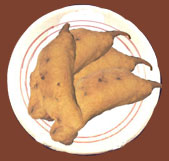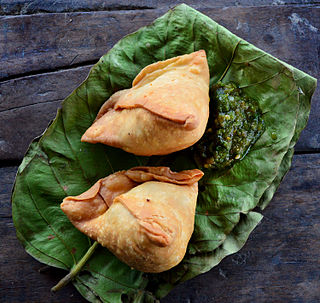
A samosa from the Persian word Sambosag (سنبوسگ) is a fried South Asian and West Asian snack. It is a pastry with a savory filling, mostly vegetables, spiced potatoes, onions, peas, also non-vegetarian meat, or fish. It is made into different shapes, including triangular, cone, or crescent, depending on the region. Samosas are often accompanied by chutney, and have origins in medieval times or earlier. Sweet versions are also made. Samosas are a popular entrée, appetizer, or snack in the cuisines of South Asia, West Asia, Central Asia, East Africa and their South Asian diasporas.

Vada pav, alternatively spelt wada pao, is a vegetarian fast food dish native to the Indian state of Maharashtra. The dish consists of a deep fried potato dumpling placed inside a bread bun (pav) sliced almost in half through the middle. It is generally accompanied with one or more chutneys and a green chili pepper. Although it originated as an affordable street food in Mumbai, it is now served in food stalls and restaurants across India. It is also called Bombay burger in keeping with its origins and its resemblance in physical form to a burger.
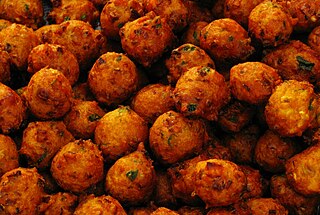
Bonda is a deep-fried South Indian potato snack that has various sweet and savory versions in different regions. The most common is aloo bonda, and other region-specific variations include potato replaced with sweet potato, tapioca, grated pineapple, green peas, paneer, or other ingredients.

Pakora is a fritter originating from the Indian subcontinent. They are sold by street vendors and served in restaurants across South Asia. It often consists of vegetables such as potatoes and onions, which are coated in seasoned gram flour batter and deep fried.

Chaat, or chāt is a family of savoury snacks that originated in India, typically served as an hors d'oeuvre or at roadside tracks from stalls or food carts across South Asia in India, Pakistan, Nepal and Bangladesh. With its origins in Uttar Pradesh, India, chaat has become immensely popular in the rest of South Asia.
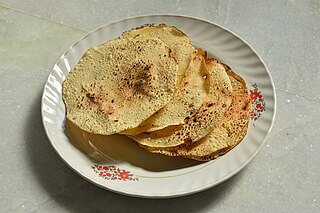
A papadam, also known as papad, is a snack that originated in the Indian subcontinent. Dough of black gram bean flour is either deep fried or cooked with dry heat until crunchy. Other flours made from lentils, chickpeas, rice, tapioca, millet or potato are also used. Papadam is typically served as an accompaniment to a meal in India, Pakistan, Bangladesh, Nepal, Sri Lanka and the Caribbean or as an appetizer, often with a dip such as chutneys, or toppings such as chopped onions and chili peppers, or it may be used as an ingredient in curries.

Rajasthani cuisine is the traditional cuisine of the Rajasthan state in north-west India. It was influenced by various factors like the warlike lifestyles of its inhabitants, the availability of ingredients in an arid region and by Hindu temple traditions of sampradayas like Pushtimarg and Ramanandi. Food that could last for several days and could be eaten without heating was preferred.
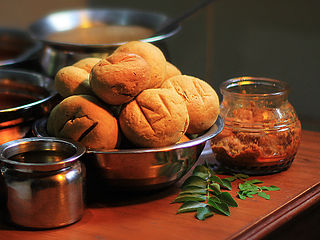
Baati is a hard, unleavened bread cooked in most areas of Rajasthan, and in some parts of Madhya Pradesh and Gujarat states of India. It is prized for its long shelf life and high nutritional content, and, in desert areas, for the minimal quantity of water required for its preparation. Baati is commonly eaten with dal, hence also referred to as dal baati. In some regions, especially Madhya Pradesh, it is also paired with a roasted aubergine mash called bharta. Baati is also closely related to Litti (cuisine), popular in eastern Uttar Pradesh (Varanasi) and western Bihar. Litti is eaten with potato, tomato and roasted aubergine.
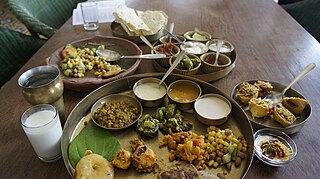
Gujarati cuisine is the cuisine of the Indian state of Gujarat. The typical Gujarati thali consists of rotli, dal or curry, rice, and shaak. The thali will also include preparations made from pulses or whole beans such as moong, black eyed beans etc., a snack item (farsaan) like dhokla, pathra, samosa, fafda, etc. and a sweet (mishthaan) like mohanthal, jalebi, sevaiya etc.

A bhaji or bajji is a type of fritter originating in the Indian subcontinent. It is made from spicy hot vegetables, commonly onion, and has several variants. It is a popular snack food in India and is also very popular in Pakistan. It can be found for sale in street-side stalls, especially in tapris and dhabas. It is also a common starter in Anglo-Indian cuisine across the United Kingdom.
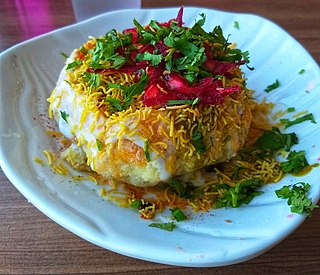
Kachori is a deep-fried, spicy, stuffed pastry originating from the Marwar region of Rajasthan, India. It is made of maida filled with a stuffing of baked mixture of moong dal or onions, besan, coriander, red chili powder, salt, and other Indian spices and deep-fried in vegetable oil until crispy golden brown. It is served hot with sweet and spicy tamarind chutney or occasionally with mint and green chilli chutney.
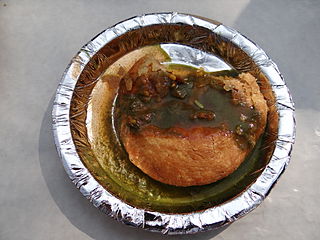
Kanda Kachori or Pyaaz Kachori is a crispy, flaky, deep-fried pastry filled with spiced onion stuffing. It is typically served hot with a sweet and spicy tamarind chutney. Originating in the city of Jodhpur, pyaaz kachori is now enjoyed throughout Rajasthan and North India.
Bhojpuri cuisine is a style of food preparation common among the Bhojpuri people of Bihar, Jharkhand and eastern Uttar Pradesh in India, and also the Terai region of Nepal. Bhojpuri foods are mostly mild and tend to be less hot in terms of spices used. The cuisine consists of both vegetable and meat dishes.

Batata vada is a popular vegetarian fast food dish from the Indian state of Maharashtra. The dish consists of a mashed potato patty coated with chickpea flour, which is then deep-fried and served hot with chutney. The vada is typically around two or three inches in diameter. Across different regions of India, this dish is also known as aloo bonda, aloo vada, batata bonda, potato bonda and potato vada.

Sabudana vada, also called 'sabu vada', is a traditional deep-fried fritter from Maharashtra, India. It is made from tapioca pearls (sabudana), mashed potatoes, peanuts and spices. It is often served with a spicy green chutney along with hot chai and is best eaten fresh. In other parts of the country, Sabudana vada is the best option to have when fasting. It's usually eaten during religious festivals and during fast/vrat/upvaas, especially in Navratri vrats. Like all vadas, these are best eaten fresh. Sabudana vadas are crunchy and "melt in the mouth."
Bihari cuisine is eaten mainly in the eastern Indian state of Bihar, as well as in the places where people originating from the state of Bihar have settled: Jharkhand, Eastern Uttar Pradesh, Bangladesh, Nepal, Mauritius, South Africa, Fiji, some cities of Pakistan, Guyana, Trinidad and Tobago, Suriname, Jamaica, and the Caribbean. Bihari cuisine includes Angika cuisine, Bhojpuri cuisine, Maithil cuisine and Magahi cuisine. Dal Puri
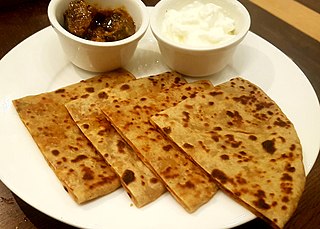
Aloo paratha is a paratha stuffed with potato filling native to the Indian subcontinent. It is traditionally eaten for breakfast.

Andhra cuisine, culturally known as Telugu cuisine, is a cuisine of India native to the state of Andhra Pradesh and is the culinary style of Telugu people. It is generally known for its tangy, hot, and spicy taste.

Vada, vadai, wada, bara, or bora is a category of savoury fried snacks native to India. Vadas can be described variously as fritters, cutlets, or dumplings. Vadas are sometimes stuffed with vegetables and traditionally served with chutneys and sambar.
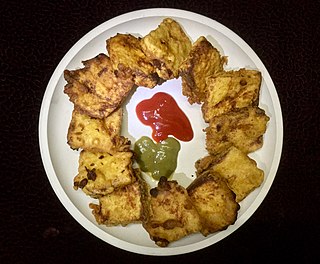
Bread pakora is an Indian fried snack. It is also known as bread bhaji. A common street food, it is made from bread slices, gram flour, and spices among other ingredients.



















